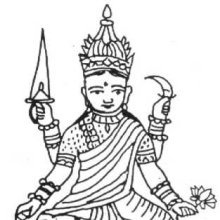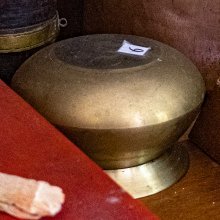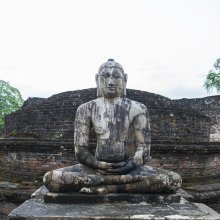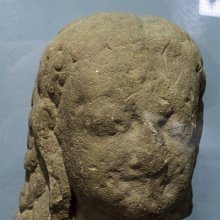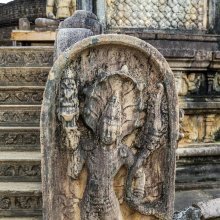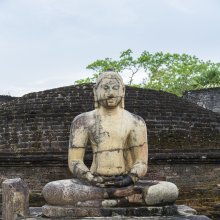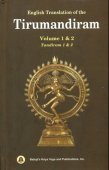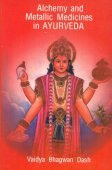Round: 2 definitions
Introduction:
Round means something in Hinduism, Sanskrit. If you want to know the exact meaning, history, etymology or English translation of this term then check out the descriptions on this page. Add your comment or reference to a book if you want to contribute to this summary article.
Images (photo gallery)
(+28 more images available)
In Hinduism
Natyashastra (theatrics and dramaturgy)
Source: Shodhganga: Elements of Art and Architecture in the Trtiyakhanda of the Visnudharmottarapurana (natya)Round-shaped objects are associated with Padmakośa-hasta: one of the twenty-two Single-hand Gestures (in Indian Dramas) (known as asaṃyuktahastas), according to the Viṣṇudharmottarapurāṇa, an ancient Sanskrit text which (being encyclopedic in nature) deals with a variety of cultural topics such as arts, architecture, music, grammar and astronomy.—The word padmakośa means the calyx of a lotus. [...] The uses of the padmakośa-hasta posture are not mentioned in the Viṣṇudharmottarapurāṇa. But according to the Abhinayadarpaṇa, this posture denotes some round shaped objects like breast of a woman, ball, round shaped cooking pot, egg and bell. The padmakośa posture is also used to show the blowing buds of flowers like marigold, lotus etc. Some kind of fruits like mango and wood apple are also portrayed with his hand posture.

Natyashastra (नाट्यशास्त्र, nāṭyaśāstra) refers to both the ancient Indian tradition (shastra) of performing arts, (natya—theatrics, drama, dance, music), as well as the name of a Sanskrit work dealing with these subjects. It also teaches the rules for composing Dramatic plays (nataka), construction and performance of Theater, and Poetic works (kavya).
Vastushastra (architecture)
Source: Shodhganga: Elements of Art and Architecture in the Trtiyakhanda of the Visnudharmottarapurana (vastu)Round or Circular-shaped Temples (in ancient Indian architecture) are described in literature such as the Viṣṇudharmottarapurāṇa, an ancient Sanskrit text which (being encyclopedic in nature) deals with a variety of cultural topics such as arts, architecture, music, grammar and astronomy.—Temples like saumudga, nandī, vṛtta, vṛṣa etc. were constructed in circular or round shape. According to Viṣṇudharmottarapurāṇa, the kaṭi i.e., waist part and the mekhalā i.e., the slop of the digvandha type of temple should be made in circular shape. Ānanda type of temple should be constructed in square or circular shape.

Vastushastra (वास्तुशास्त्र, vāstuśāstra) refers to the ancient Indian science (shastra) of architecture (vastu), dealing with topics such architecture, sculpture, town-building, fort building and various other constructions. Vastu also deals with the philosophy of the architectural relation with the cosmic universe.
See also (Relevant definitions)
Starts with (+16): Round calabash, Round cardamom, Round chili, Round chilli, Round eye, Round leaf poverty bush, Round Of Rebirth, Round siam cardamom, Round-fruited panic grass, Round-head bush-clover, Round-leaf dogwood, Round-leaf grewia, Round-leaf pyrola, Round-leaf salago, Round-leaf wild buckwheat, Round-leaved bloodwood, Round-leaved dogwood, Round-leaved goosefoot, Round-leaved kiaat, Round-leaved teak.
Ends with: Auspicious ground, Causal Ground, Cremation ground, Gill-overthe-ground, Karma Round, Kukuround, Old-man-in-theground, Sacrificial ground, Underground.
Full-text (+4275): Bhramaṇa, Mandala, Bhramin, Vivritta, Avritta, Parikrama, Gastakari, Paritas, Coragasta, Gasta, Aveshtana, Paryayana, Parivesha, Nivi, Parivritta, Vrittakaya, Pari, Cakragandu, Vritta, Avashakthika.
Relevant text
Search found 410 books and stories containing Round; (plurals include: Rounds). You can also click to the full overview containing English textual excerpts. Below are direct links for the most relevant articles:
Apadana commentary (Atthakatha) (by U Lu Pe Win)
Commentary on Biography of the thera Pañcasīlasamādāniya < [Chapter 3 - Subhūtivagga (section on Subhūti)]
Commentary on the stanza beginning with diṭṭhivisūkāni (wriggling of opinion) < [Commentary on biography of Silent Buddhas (Paccekabuddha)]
Commentary on Biography of the thera Uttiya < [Chapter 3 - Subhūtivagga (section on Subhūti)]
A Discourse on Paticcasamuppada (by Venerable Mahasi Sayadaw)
Chapter 5 - Present Effect Due To Past Cause < [Part 9]
Chapter 2 - Three Cycles < [Part 10]
Chapter 8 - Conclusion < [Part 10]
Vinaya (3): The Cullavagga (by T. W. Rhys Davids)
Cullavagga, Khandaka 8, Chapter 5 < [Khandaka 8 - Regulations as to the Duties of the Bhikkhus towards one Another]
Cullavagga, Khandaka 5, Chapter 10 < [Khandaka 5 - On the Daily Life of the Bhikkhus]
Cullavagga, Khandaka 10, Chapter 16 < [Khandaka 10 - On the Duties of Bhikkhunis]
Buddha Desana (by Sayadaw U Pannadipa)
Chapter 4 - Three Rounds In The Process Of Existence < [Part II - The Dependent Origination]
Chapter 6 - Links In Reverse Order < [Part II - The Dependent Origination]
Chapter 3 - Two Root Defilements < [Part II - The Dependent Origination]
The Skanda Purana (by G. V. Tagare)
Chapter 7 - Influence of Acaleśvara (Acala-īśvara) < [Section 3 - Arbuda-khaṇḍa]
Chapter 42 - To donate bull and listen to the greatness of Dvārakā < [Section 4 - Dvārakā-māhātmya]
Chapter 33 - Dvārakā as an abode to all regions and places of pilgrimage < [Section 4 - Dvārakā-māhātmya]
The Agnistoma Somayaga in the Shukla Yajurveda (by Madan Haloi)
Somasaṃsthā (7): Aptoryāma < [Chapter 3 - The Somayāga]
Somasaṃsthā (6): Atirātra < [Chapter 3 - The Somayāga]
Part 5.4: Mid-day soma pressing (mādhyandina-savana) < [Chapter 4 - The Agniṣṭoma Ritual]
Related products
(+1 more products available)
